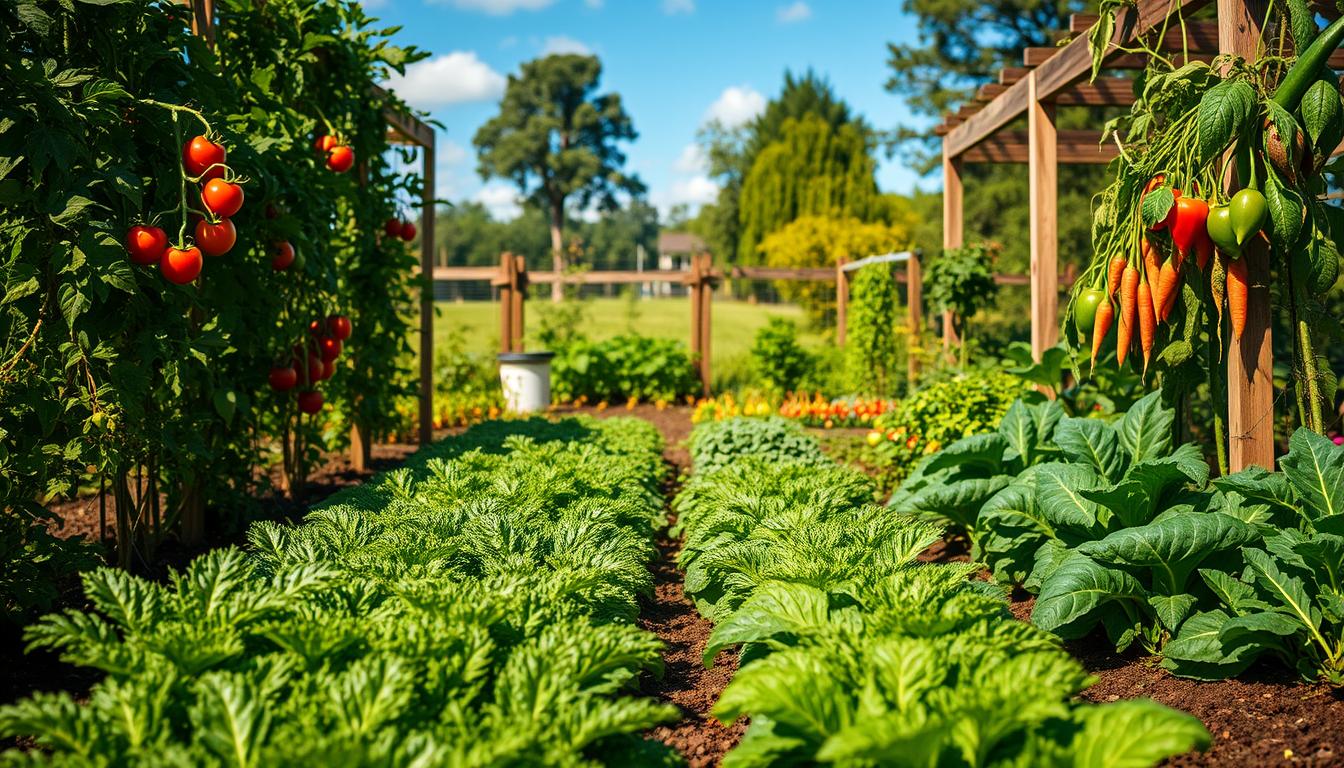Growing your own vegetables at home can be both rewarding and cost-effective. Freshly harvested produce like sun-warmed tomatoes or crisp lettuce brings unmatched flavor to your meals. For beginners, the process doesn’t have to be overwhelming. Starting small, such as with a 4×4 ft raised bed or a 10×10 ft plot, ensures manageable success.

Proper site selection is crucial, as 94% of successful gardeners emphasize. Look for a spot with at least six hours of sunlight daily. Preparing the soil and choosing beginner-friendly plants like beans and lettuce can boost your chances of success. The National Gardening Association recommends starting with 5-7 vegetable types to keep things simple.
Tools like the Old Farmer’s Almanac Garden Planner can help you design your layout efficiently. With the right approach, even first-time gardeners can enjoy a thriving vegetable garden. For more detailed steps, check out this beginner’s guide.
Key Takeaways
- Fresh, homegrown vegetables offer superior flavor and cost savings.
- Begin with a small plot or raised bed for easier management.
- Choose a sunny location for optimal plant growth.
- Start with beginner-friendly crops like lettuce and beans.
- Use planning tools to design your garden layout effectively.
Why Start a Veggie Garden?
Growing your own food offers unmatched benefits for your health and wallet. Freshly harvested vegetables contain 40% more nutrients than store-bought produce, ensuring you get the most out of every bite. Plus, the average family can save up to $600 a year by growing their own vegetables.
Therapeutic benefits are another reason to consider this rewarding activity. Studies show that gardening reduces stress markers by 72%, making it a calming way to spend your time. It’s not just about the harvest; it’s about the journey.
“There’s something deeply satisfying about nurturing plants from seed to table. It’s a connection to nature that brings joy and fulfillment.”
Homegrown vegetables also offer superior flavor. Compare a store-bought tomato to one you’ve grown yourself, and the difference is undeniable. Beyond taste, growing your own food enhances food security. 75% of gardeners report increased pantry resilience, knowing they have a steady supply of fresh produce.
Environmental impact is another key factor. Growing 1 pound of vegetables at home creates only 25% of the carbon footprint of store-bought produce. It’s a small but meaningful way to reduce your environmental impact.
Gardening also promotes physical activity, burning around 150 calories every 30 minutes. It’s a fun and productive way to stay active. Plus, it’s an excellent educational opportunity for children, teaching them the seed-to-table process and fostering a love for nature.
| Aspect | Homegrown Vegetables | Store-Bought Vegetables |
|---|---|---|
| Nutrient Content | 40% higher | Standard |
| Cost | $600/year savings | Higher cost |
| Carbon Footprint | 25% of store-bought | Higher |
| Flavor | Superior | Mild |
Whether it’s for health, savings, or the joy of nurturing plants, growing your own vegetables is a decision you won’t regret. It’s a rewarding way to connect with nature and enjoy fresh, flavorful food all season long.
Choosing the Perfect Location
Finding the right spot for your plants is the first step to a thriving harvest. The location you choose impacts sunlight exposure, drainage, and protection from harsh elements. A well-planned space ensures your plants grow strong and healthy.
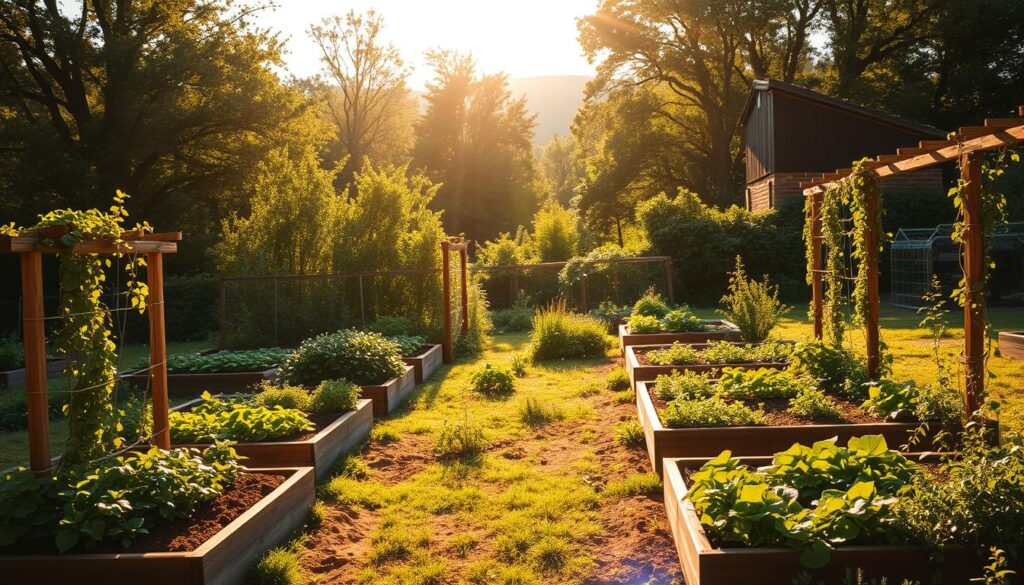
Sunlight and Drainage
Plants need at least 6-8 hours of direct sunlight daily for optimal growth. Use smartphone apps to map sunlight patterns in your chosen spot. This helps identify the sunniest areas for fruiting plants like tomatoes and peppers.
Good drainage is equally important. Test your soil by digging a 12-inch hole and filling it with water. If it drains in 2-4 hours, your spot is ideal. For clay soils, consider raised beds, which improve drainage by 300%.
Protection from Wind and Pests
Strong winds can stress plants, reducing their growth by 45%. Use burlap screens or plant perennial hedges as windbreaks. These barriers shield your plants while adding beauty to your space.
Pests can also threaten your harvest. Install 18-inch chicken wire barriers to keep ground pests like rabbits away. For microclimates, avoid frost pockets and opt for south-facing slopes, which stay warmer longer.
| Factor | Ideal Condition | Solution |
|---|---|---|
| Sunlight | 6-8 hours daily | Sun mapping apps |
| Drainage | 2-4 hours to drain | Raised beds |
| Wind Protection | Reduces stress by 45% | Burlap screens |
| Pest Control | Ground pest barriers | Chicken wire |
Preparing Your Soil for Success
Healthy soil is the foundation of a thriving vegetable patch. Without proper preparation, even the best plants struggle to grow. Testing and amending your soil ensures it provides the nutrients and structure your plants need.
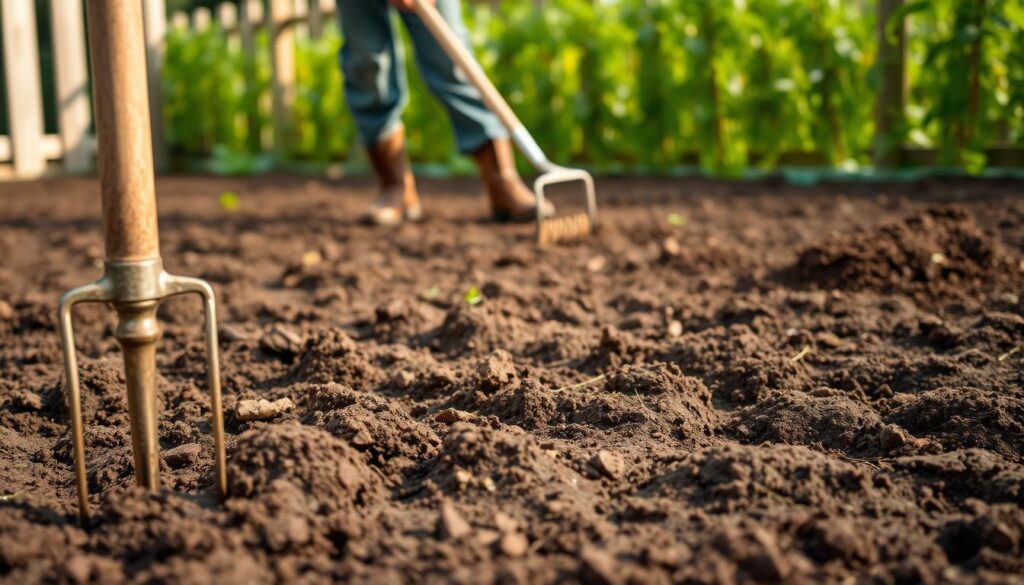
Soil Testing and Amendments
Start by testing your soil’s pH and nutrient levels. Most vegetables prefer a pH of 6.0-7.0. Use a soil test kit to measure nitrogen (N), phosphorus (P), and potassium (K) ratios. This helps you identify what your soil lacks.
Adding compost is one of the best ways to improve soil structure. A 3-inch layer can increase yield by 60%. Organic amendments like worm castings or mushroom compost enrich the soil naturally. Compare this to spending $300 on failed crops—a $25 soil test is a smart investment.
Raised Beds vs. In-Ground Planting
Raised beds offer better drainage and easier maintenance. Cedar beds last 10-15 years, while pine lasts only 5 years. Corrugated metal and composite materials are also durable options.
In-ground planting works well for deep-rooted vegetables like carrots, which need 12 inches of soil. Lettuce, with its shallow roots, thrives in just 6 inches. Choose the method that suits your space and plant types.
| Factor | Raised Beds | In-Ground Planting |
|---|---|---|
| Drainage | Excellent | Moderate |
| Cost | Higher upfront | Lower upfront |
| Lifespan | 10-15 years (cedar) | N/A |
| Root Depth | Adjustable | Fixed |
For more tips on soil preparation, check out this beginner’s guide. With the right approach, your soil will be ready to support a bountiful harvest.
Selecting the Right Vegetables
Choosing the right vegetables can make or break your gardening experience. For beginners, picking crops that are easy to grow ensures a rewarding start. Consider your climate and the season to maximize your harvest.
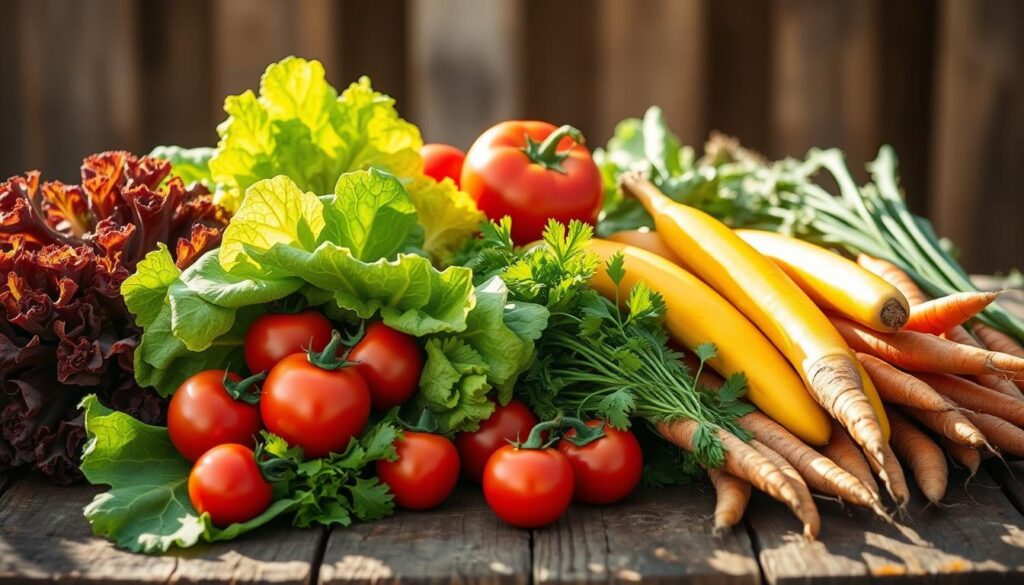
Easy-to-Grow Vegetables for Beginners
Some vegetables are perfect for those new to gardening. Radishes, for example, mature in just 22 days, making them the fastest crop to grow. Lettuce and beans are also excellent choices, requiring minimal care and offering quick results.
Cherry tomatoes have a 90% success rate, compared to heirlooms at 60%. Cucumbers and broccoli are other beginner-friendly options. These vegetables are forgiving and adapt well to various conditions.
Considering Your Climate and Season
Your location plays a big role in what you can grow. USDA zones help determine planting times. For every zone north, add 2 weeks to your planting schedule. This ensures your crops thrive in the right conditions.
Spring and summer are ideal for tomatoes and cucumbers. Kale can tolerate frost down to -2°C, while basil needs temperatures above 10°C. Plan your planting around these factors for the best results.
| Vegetable | Days to Maturity | Frost Tolerance |
|---|---|---|
| Radishes | 22 | Moderate |
| Lettuce | 30-60 | Low |
| Beans | 50-60 | Low |
| Cherry Tomatoes | 60-70 | Low |
| Kale | 55-75 | High |
For apartment gardeners, microgreens are a great option. They grow quickly and require minimal space. Seed vendors like Burpee and Botanical Interests offer reliable options for beginners.
Planting Your Veggie Garden
Getting your plants in the ground correctly sets the stage for a successful harvest. Whether you’re using seeds or seedlings, understanding the basics of planting ensures your crops grow strong and healthy. Proper spacing and depth are key factors that can make or break your garden’s productivity.
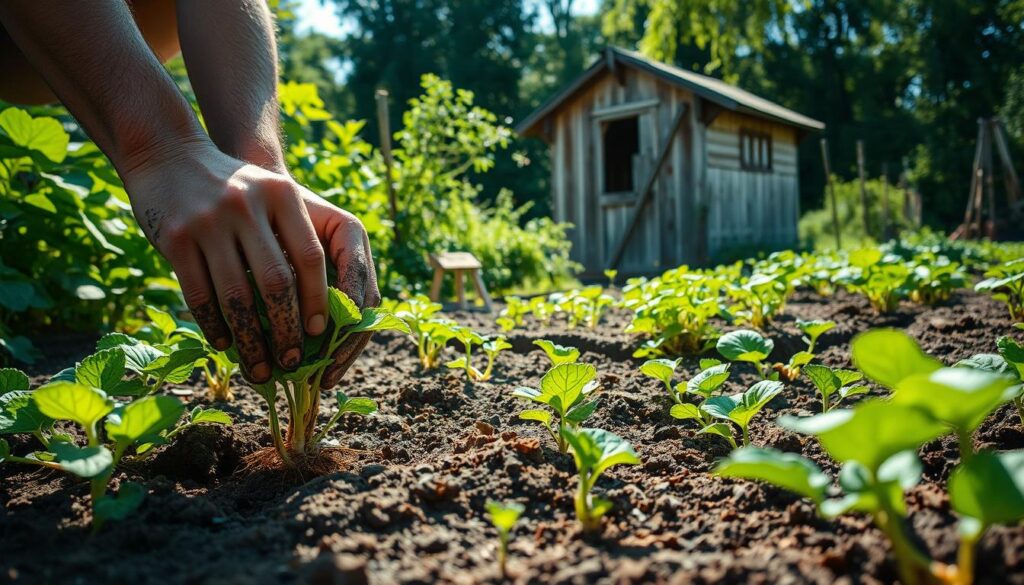
Seed Starting vs. Transplants
Starting with seeds gives you full control over the growing process. However, seedlings establish 2 weeks faster than direct-sown seeds, saving you valuable time. If you choose seeds, check their viability. For example, onion seeds last only 1 year, while tomato seeds remain viable for 4 years.
Transplants require a hardening-off process. Gradually expose them to outdoor conditions over 7-10 days to prevent shock. This step ensures they adapt well to their new environment.
Proper Spacing and Depth
Overcrowding can reduce yields by 40%, so proper spacing is crucial. Use a square foot gardening guide to maximize your space. For example, plant lettuce 4 per square foot, but give tomatoes 1 square foot each.
Planting depth also matters. Bury 2/3 of a tomato stem to encourage stronger roots. Peas need only 1 inch of soil, while corn requires 2 inches. Follow these guidelines to give your veggies the best start.
- Seed viability: onion (1 year) vs. tomato (4 years)
- Transplant hardening-off schedule: 7-10 days
- Square foot spacing: lettuce (4/sq ft) vs. tomatoes (1/sq ft)
- Depth gauge: peas (1″) vs. corn (2″)
- Moon phase planting: myths vs. scientific facts
Watering and Mulching Tips
Proper watering and mulching are essential for a thriving harvest. These practices not only keep your plants healthy but also save time and resources. By mastering these techniques, you can ensure your garden stays productive throughout the season.
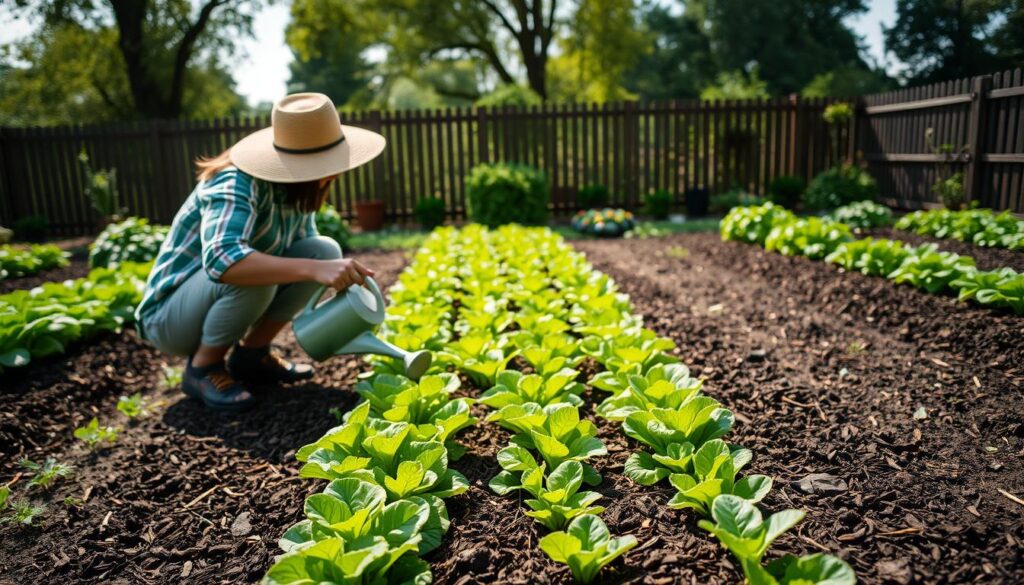
Efficient Watering Techniques
Watering your plants the right way is crucial for their growth. Drip irrigation reduces water use by 50%, making it an eco-friendly choice. This method delivers water directly to the roots, minimizing evaporation and runoff.
Morning watering is another effective strategy. It reduces fungal disease by 70% compared to evening watering. To check soil moisture, use the finger test or a moisture meter for accuracy. Both methods ensure your plants get the hydration they need without overwatering.
For larger gardens, consider a 55-gallon rain barrel. This setup can save up to 1,300 gallons of water annually. Soaker hoses are another option, with flow rates tailored to your garden’s size and needs.
Mulching to Prevent Weeds
Mulching is a simple yet powerful way to protect your plants. A 3-inch layer of straw mulch lowers soil temperature by 6°F, keeping roots cool during hot summer days. It also prevents weeds by blocking sunlight, reducing the need for manual weeding.
Living mulch, like clover or creeping thyme, offers additional benefits. These plants improve soil health and attract beneficial insects. Compare this to synthetic mulch, which lacks these advantages but lasts longer.
| Technique | Benefit | Example |
|---|---|---|
| Drip Irrigation | Reduces water use by 50% | Eco-friendly watering |
| Morning Watering | Reduces fungal disease by 70% | Healthier plants |
| Straw Mulch | Lowers soil temp by 6°F | Cooler roots |
| Living Mulch | Improves soil health | Clover or thyme |
By combining efficient watering and mulching, you can create a thriving garden that’s both productive and sustainable. These practices ensure your plants stay healthy while conserving resources.
Maintaining Your Veggie Garden
Keeping your vegetable patch healthy requires consistent care and attention. Proper maintenance ensures your plants grow strong and produce abundant crops. From fertilizing to pest control, every step plays a vital role in your garden’s success.

Fertilizing and Pest Control
Fertilizing your plants is essential for robust growth. Fish emulsion, for example, boosts growth by 30%. It’s rich in nutrients and easy to apply. For best results, use it every 2-3 weeks during the growing season.
Pests can threaten your harvest, but natural solutions work wonders. Neem oil controls 85% of common pests like aphids and mites. For an organic pest spray, mix garlic and chili with water. This homemade remedy keeps pests at bay without harmful chemicals.
Crop rotation is another effective strategy. Changing types of vegetables in each bed prevents soil depletion and reduces pest buildup. Use a crop rotation planner to organize your planting schedule.
Regular Weeding and Pruning
Weeding is crucial for a healthy garden. Daily 15-minute sessions prevent 90% of weed problems. Pull weeds by hand or use a hoe for larger areas. Mulching also helps by blocking sunlight, which stops weeds from sprouting.
Pruning encourages better growth and higher yields. For tomatoes, remove suckers on indeterminate types to focus energy on fruit production. Determinate varieties, however, require minimal pruning. Always use clean, sharp tools to avoid damaging your plants.
Attracting beneficial insects like ladybugs and lacewings can also help. Build insect hotels to provide them with shelter. These insects naturally control pests, reducing the need for chemical interventions.
| Task | Benefit | Example |
|---|---|---|
| Fertilizing | Boosts growth by 30% | Fish emulsion |
| Pest Control | Controls 85% of pests | Neem oil |
| Weeding | Prevents 90% of weeds | Daily 15-minute sessions |
| Pruning | Increases yields | Remove tomato suckers |
Conclusion
Your journey into gardening can lead to a bountiful harvest and endless rewards. For beginners, the first year is often a learning experience, but 68% of gardeners expand their plots after seeing success. With an average yield of 1/2 pound of vegetables per square foot, your efforts can quickly pay off.
Planning is key to a thriving garden. Use a seasonal calendar to track planting and harvesting times. If space is limited, consider joining a community garden to share resources and knowledge. For surplus produce, learn the basics of freezing or canning to enjoy your harvest all year.
Local master gardener programs are a great way to deepen your skills. These programs offer expert advice and support, helping you grow healthier plants and more flavorful vegetables. Whether you’re a beginner or an experienced gardener, there’s always something new to learn.
Gardening is a rewarding way to connect with nature and enjoy fresh, homegrown food. With the right care and planning, your garden can thrive and provide endless benefits for years to come.

